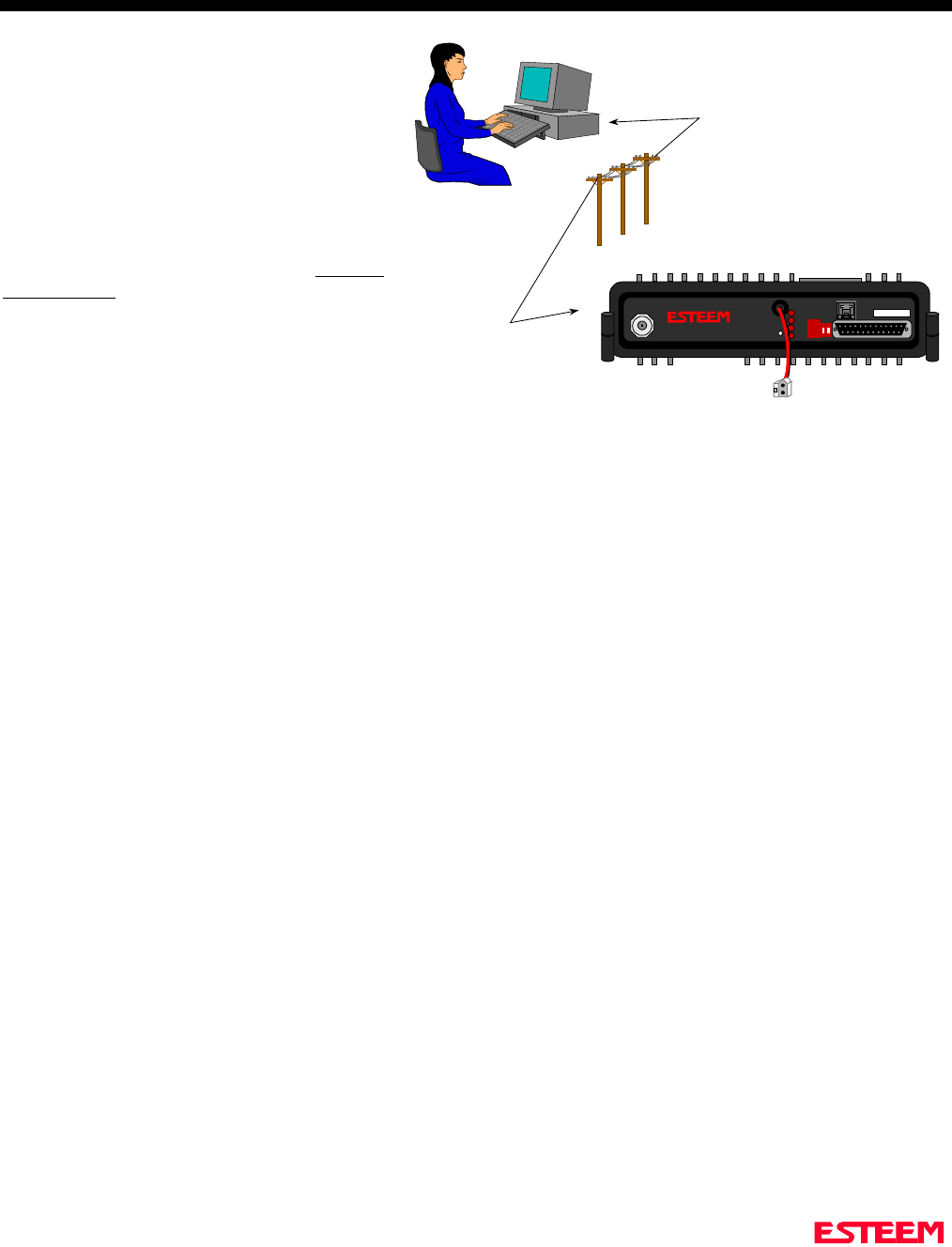Electronic Systems Technology ESTEEM192S Wireless Modem User Manual PART 3
Electronic Systems Technology Wireless Modem PART 3
Contents
USER MANUAL PART 3

CHAPTER 3
PROGRAMMING ESTEEM FEATURES
DIGI-REPEATING FEATURE
GLOBAL BROADCAST FEATURE
AUTO TRANSMIT FEATURE
AUTO CONNECT FEATURE
MULTI-CONNECT FEATURE
REMOTE PROGRAMMING FEATURE
SECURITY FEATURE
HARDWARE RING LINE FEATURE
PACKET MONITOR FEATURE
USING THE INFRARED COMMUNICATIONS PORT
USING THE PHONE COMMUNICATIONS PORT

CHAPTER 3
PROGRAMMING ESTEEM FEATURES
Revised: 11 Feb 99 3-2
Listed in this chapter are the major ESTeem features and
programming examples on how to use them. These features
are individual building blocks to solve your application
needs. Remember your particular application my require
one or more of these features enabled.
DIGI-REPEATING
The Repeater feature allows an ESTeem to relay it's
respective transmission or packet through a maximum of
three ESTeems to increase the operating range of the unit.
Any ESTeem in your radio network can function as a
repeater for any other ESTeem. This is independent of the
fact that the ESTeem being used as a repeater is linked or
connected to another node, therefore an ESTeem can
function as a repeater, operational node, or both at the same
time. The data that is digi-repeated through an ESTeem
will not be output through the repeating ESTeem’s
RS-232C port.
To specify one or more ESTeems as repeaters, the
CONNECT command has been expanded to except up to
three added addresses as follows:
CONN r1,r2,r3,da
r1 = Address (1 to 254) of first ESTeem repeater.
r2 = Address (1 to 254) of second ESTeem repeater.
r3 = Address (1 to 254) of third ESTeem repeater.
Da = Address (1 to 255) of destination ESTeem.
Note: Address 255 is used for Global.
When transmitting packets through other ESTeems, the
source ESTeem will automatically adjust it's FRACK time
to allow additional time for the packet to reach its
destination and for the returned acknowledgment. Frack
time takes into account the packet size and the number of
repeaters specified. The ACK still comes from the
destination ESTeem, not the first or any repeater.
For testing purposes, you can loop back a connection to
yourself by placing your source address in the destination
address of the repeater string. Any data transmitted will
repeat through the repeater address and display back on the
screen.
Example:
CONN r1,Sa
r1 = Address (1 to 254) of first ESTeem repeater.
Sa = Address of local ESTeem.
Any ESTeem command in this manual that uses an address
string can be configured to use the Digi-repeating feature.
Example:
SETC r1,r2,r3,da
GLOBAL BROADCAST
Global broadcast is the ability of one ESTeem to transmit
it's message to more than one ESTeem at one time. All
ESTeems within radio range will receive the message
whether or not they are connected to another ESTeem or in
command or converse mode.
You can put your ESTeem in Global by connecting or
programming the SETC to address 255. Address 255 is a
non assignable unit address and is used by the ESTeem
CPU to access this special mode. When an ESTeem is in
Global, the standard ACK protocol from the receiving
ESTeem is disabled, but the 32 bit CRC error checking on
the received ESTeem is still operational. When you
perform CONN 255 <cr> from the COMMAND MODE
the ESTeem will immediately go to the CONVERSE
MODE (* is displayed). All messages sent will be
transmitted globally to all ESTeems in radio range.
In the ESTeem you have a GLOBAL (on/off) command.
When GLOBAL = On, you can receive Global
transmissions. If GLOBAL = Off you will not display
Global transmissions from other ESTeems.
Note: Factory default is ON.
By using the repeater function you can transmit Global
messages from another ESTeem using the Digi-repeating
feature.
Example:
CONN 10,20,30,255<cr>
SETC 10,20,30,255<cr>
By adjusting these commands you can route from unit 10 to
20, 20 to 30, and go Global at unit 30.

CHAPTER 3
PROGRAMMING ESTEEM FEATURES
Revised: 11 Feb 99 3-3
You can enable global transmissions in more than one
ESTeem in your network. This will allow global
communications between all ESTeems within radio range.
AUTO TRANSMIT
The Auto Transmit feature of the ESTeem allows the user
to transmit a data packet without filling up the PACKLEN
(packet length) buffer or defining a special control character
using the SENDPAC (send packet) variable. The Auto
Transmit feature is a timer that is enabled in the ESTeem
that monitors traffic in and out of the RS-232C port. If
there are characters in the RS-232C buffer, the termination
control timer starts from the time the last receive or
transmitted character is updated in the buffer. If the
termination time expires before another character is
received or transmitted, the received characters are
transmitted.
To enable this feature perform the following from the
COMMAND MODE:
TERMC (on/off) = On. Enable termination control.
TERMT (10-255) = One unit number equals 1ms.
TERMC is the termination control command. TERMT is
the termination time command. Factory default for
TERMC = Off and TERMT = 10.
AUTO CONNECT
The Auto Connect feature allows the user to program the
ESTeem to perform a CONNECT to another ESTeem when
data is sent to the RS-232C communications port.
To enable this feature perform the following from the
COMMAND MODE:
SETCON (1-255) = Address of destination ESTeem.
Remember, you can use the Repeater routing (r1,r2,r3,da)
or put the ESTeem in Global (address 255). SETCON is
the set connect command.
SA SAVE command. This will save the SETC
variable to the non volatile memory so that it will
not be lost when the ESTeem is RESET.
Bit 8 (on/off) = On. Bit 8 is located on the RS-232C
SETUP SWITCH on the rear of the
ESTeem. The ESTeem must be RESET
after the Bit has been changed to be read
by the ESTeem CPU.
RESET ESTeem RESET is located on the front panel
OFF/ON switch. The T/E light on the
front panel of the ESTeem should now
flash at a two times per second rate.
MULTI-CONNECT
The actual polling of the ESTeem must originate from the
host device connected to the ESTeem using the CONNECT
command to originate the initial connect and the
COMMAND character to return from the CONVERSE
mode to the COMMAND mode. The first time around the
pole a CONNECT data packet (rf transmission) will be
initiated. When a link is established, it is held internally in
the ESTeem connect table. The next time around the pole
to the same address, the link status will be checked in the
ESTeem table. If the address indicates a link has already
been established, then only data and its corresponding ACK
will be transmitted to that node. This greatly increases
polling time by eliminating the usual
CONNECT/DISCONNECT sequence each time except
when communication is first established.
The MULTID command allows the user to send data to a
specific ESTeem address from the CONVERSE Mode by
specifying the ESTeem address routing before the data
packet. This feature will also display the address of the
sending ESTeem on any received data.
Example Of Transmitted Data:
[001]DATA Routes data to an ESTeem addressed 1.
[100,200,250,1]DATA Routes data to an ESTeem
addressed 1 via ESTeems
addressed 100, 200, and 250.
The above example replaces the CONNECT command
from the COMMAND Mode.
Received data packets will have the address of the ESTeem
that sent the data at the beginning of the data packet.
Example Of Received Data:
[004]RECEIVED DATA Data received from an
ESTeem addressed 4.

CHAPTER 3
PROGRAMMING ESTEEM FEATURES
Revised: 11 Feb 99 3-4
[030,100,244,004] Data received from an ESTeem
addressed 4 via ESTeems addressed
30, 100, and 244.
MULTID (on/off) = On Enables this feature. Factory
default = OFF.
REMOTE PROGRAMMING
The Remote Programming feature allows the user to
remotely program ESTeems in his network. When a
connection has been made with the remote ESTeem the
RPG: prompt will be displayed showing that you are now in
the COMMAND mode of that remote ESTeem.
To enable this feature perform the following from the
COMMAND MODE:
PROG (1-254) Address of destination ESTeem.
Note: You can also use the Repeater routing
(r1,r2,r3,da) to reach the destination ESTeem. (r1
= address of first repeater, r2 = address of second
repeater, etc. da = destination address).
To end a remote programming session, type DISC
(Disconnect) and you will return to the COMMAND
prompt of your ESTeem. There is a Watch Dog Timer that
will automatically disconnect you from remote
programming if there is no activity for thirty seconds.
The REMPROG (on/off) feature is used to defeat the ability
of your ESTeem from being remotely programmed. If
REMPROG = OFF another ESTeem cannot remotely
program your unit. Factory default = ON.
SECURITY
The Security feature allows the user to lock out
programming of the ESTeem. REMEMBER TO STORE
YOUR CODE NUMBER IN A SAFE PLACE.
To enable this feature perform the following from the
COMMAND MODE:
SECURITY (1 to 100,000) Entering a security number
enables the security
feature.
SAVE To enter the security code permanently into the
ESTeem memory.
Note: When enabled, the ESTeem will output a
“Security On” message.
To disable the security feature perform the following from
the COMMAND mode.
SECURITY (1 to 100,000) Entering your security number
disables the security
feature.
SAVE To remove the security code permanently from the
ESTeem memory.
Note: When disabled, the ESTeem will output a
“Security Off” message.
HARDWARE RING LINE
When the ESTeem establishes a CONNECT or link with
another ESTeem (T/E Light on solid), pin 22 at the
ESTeem RS-232C will change from a -15 vdc voltage state
to a +15 vdc voltage state. The RING software command
allows the user to change the output from a latched state to a
pulsed state. To change the state of this line program the
following from the COMMAND mode. Factory default =
LATCH.
RING = Latch. Pin 22 is high when the ESTeem T/E light
is on solid.
RING = Pulse. Pin 22 is pulsed (positive 250 ms.) when
the ESTeem T/E light is on solid.
PACKET MONITOR

CHAPTER 3
PROGRAMMING ESTEEM FEATURES
Revised: 11 Feb 99 3-5
The PACKM [ON/OFF] command places the ESTeem in a
special packet monitor mode. When this feature is enabled
the ESTeem is placed in a receive only mode and will not
function as a normal ESTeem. The ESTeem will monitor
and report the status of all message traffic within the
network in the following format, the actual packet message
will not be outputted.
SA-xxx, DA-xxx, Type Code, R1-Repeater Status, R2-
Repeater Status, R3-Repeater Status, Data Bytes Sent
xxx = ESTeem Address
DA = Destination ESTeem
SA = Source ESTeem
R1 = Address of first ESTeem repeater.
R2 = Address of second ESTeem repeater.
R3 = Address of third ESTeem repeater.
Type Codes
I = Information
DISC = Disconnected
RR = Receive Ready
UA = Unnumbered Acknowledge
RNR = Receive Not Ready
FRMR = Frame Reject
REJ = Reject
DM = Disconnected Mode
UI = Unnumbered Information
SABM = Set Async. Balance Mode
Repeater Status
P=Pending
D= Done
USING THE INFRARED
COMMUNICATIONS PORT
The infrared (IR) communications port will allow you to
program and interrogate the ESTeem without disconnecting
the serial cable from the back of the modem. The IR port is
located on the front panel of the ESTeem, above the T/E
light.
To communicate from a computer to the ESTeem through
the IR port you will need a copy of the ESTeem Utility
Program and an ESTeem IR Communication Dongle
(ESTeem P/N AA300).
Connect the dongle directly to the serial port of the
computer. The dongle requires initialization from the
ESTeem Utilities. This initialization is done in the
Terminal Emulation on the menu select ESTeem Setup
Initialize IR Dongle. If the modem is not in the
COMMAND mode, press CTRL-C to display the CMD:
prompt.
Note:With Switch 8 (RS-232 Setup) in the On position
the ESTeem defaults the IR port to the command
mode.
The IR dongle has a range of approximately three feet,
directly in front of the port. The dongle is powered by the
serial port and requires no additional power sources.
Note: Only one of the four communications ports (RS-
232/422/485 connector, IR port, Phone Modem
Port, or Remote Programming) can be in the
Command mode at a time. When either the IR or
the Phone port switch to converse mode, the RS-
232/422/485 port is blocked from receiving any
data.
USING THE PHONE COMMUNICATIONS
PORT
ANTE
NNA
S/N:
T/E
TX
RX
PWR
IR
Port
Phone
Model 192S
Antenna 12 VDC
RESET
Infrared Communications Port for
Remote Programming and Diagnostics
Without Interruption Of The Wireless
Radio Area Network
ESTeem
Utility
IR Communications Dongal
(EST p/n AA300)
3 ft. Range
RE
SET
Figure 1: Using The IR Port

CHAPTER 3
PROGRAMMING ESTEEM FEATURES
Revised: 11 Feb 99 3-6
If your ESTeem modem has the optional phone port
installed, you have the ability to gain access to the
ESTeem from anywhere in the world through a
standard phone modem.
Connect a standard phone company line to the
ESTeem’s phone connector and dial the number
with a phone modem using the ESTeem Utility
Prpgram’s terminal emulator. Select your phone
modem manufacturer, on the menu select Terminal
Setup Modems. Select your modems manufacturer
and Model from the liste and CommPort and select
ok. The program will auto configure your modem.
Set the terminal to connect at 2400 bps. The
ESTeem will answer on the first ring. Type a
CTRL-C on the communications terminal and a
CMD: prompt should appear.
Note: When the phone port is active, the IR port
will be disabled.
Optional 2,400 Baud
Phone Modem For
Remote
Programming and
Diagnostics
ESTeem Rear View
RE
SET
ANTE
NNA
S/N:
T/E
TX
RX
PWR
IR
Port
Phone
Model 192S
Antenna 12 VDC
RESET
Figure 2: Using The Phone Port